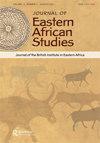公共空间中的语言政策:阿斯马拉语言景观的历史视角
IF 0.6
3区 社会学
Q2 AREA STUDIES
引用次数: 2
摘要
摘要本文对2001年至2018年间在厄立特里亚首都阿斯马拉拍摄的图片进行了语言景观分析,这些图片分别来自意大利、英国、埃塞俄比亚和厄立特里亚统治时期。该分析说明了这些符号符号,无论是石化的还是当代的,如何见证了该国各自统治者的语言和国家意识形态在可见语言中的象征性实施和体现。除了意大利语、阿姆哈拉语、提格里尼亚语和阿拉伯语之外,人们还关注英语,这是一种在英国保护国时期引入的国际语言,近年来,它在阿斯马拉成功地保持和加强了居民连接互联网作为逃离城市的手段的地位。分析的核心是公共空间的概念,它是一种多层次的社会建构现象,显示了社会事件的印记。阿斯马拉的这些历史痕迹有助于将具体的地方变成空间,并有助于记忆和传递与之相关的叙事,作为多年来共同构建并赋予阿斯马拉公共空间意义的历史和当代语言政策的反映。本文章由计算机程序翻译,如有差异,请以英文原文为准。
Language policy in public space: a historical perspective on Asmara’s linguistic landscape
ABSTRACT This article presents a linguistic landscape analysis of pictures taken in Eritrea’s capital Asmara between 2001 and 2018, stemming from the respective periods of Italian, British, Ethiopian and Eritrean rule. The analysis illustrates how these semiotic signs, fossilized as well as contemporary, bear witness of the ways in which language and state ideologies of the country’s respective rulers were symbolically implemented and enshrined in visible language. Next to Italian, Amharic, Tigrinya and Arabic, attention is given to English, the international language that was introduced during the British Protectorate period and managed to maintain and strengthen its position in Asmara in recent years in relation to the inhabitants’ connection to the internet as a means to virtually escape from the city. Central in the analysis is the notion of public space as a multilayered socially constructed phenomenon showing the imprints of societal happenings. Such traces of history in Asmara contribute to changing concrete places into spaces and as such help memorizing and handing over the narratives connected to them as reflections of historical and contemporary language policies that over the years have co-constructed and given meaning to Asmara’s public space.
求助全文
通过发布文献求助,成功后即可免费获取论文全文。
去求助
来源期刊

Journal of Eastern African Studies
AREA STUDIES-
CiteScore
3.30
自引率
7.10%
发文量
12
期刊介绍:
Journal of Eastern African Studies is an international publication of the British Institute in Eastern Africa, published four times each year. It aims to promote fresh scholarly enquiry on the region from within the humanities and the social sciences, and to encourage work that communicates across disciplinary boundaries. It seeks to foster inter-disciplinary analysis, strong comparative perspectives, and research employing the most significant theoretical or methodological approaches for the region.
 求助内容:
求助内容: 应助结果提醒方式:
应助结果提醒方式:


